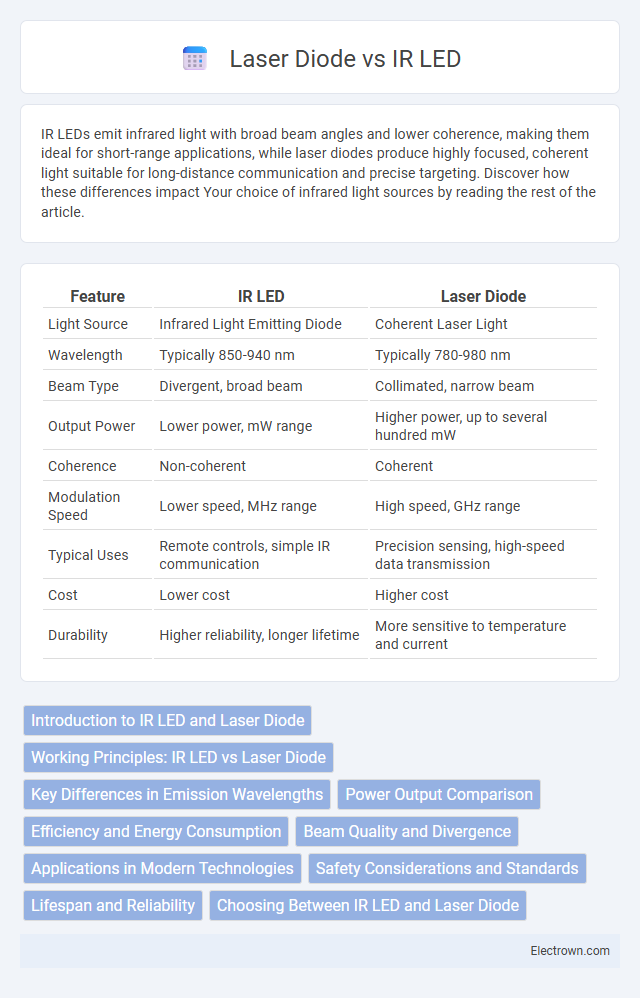IR LEDs emit infrared light with broad beam angles and lower coherence, making them ideal for short-range applications, while laser diodes produce highly focused, coherent light suitable for long-distance communication and precise targeting. Discover how these differences impact Your choice of infrared light sources by reading the rest of the article.
Table of Comparison
| Feature | IR LED | Laser Diode |
|---|---|---|
| Light Source | Infrared Light Emitting Diode | Coherent Laser Light |
| Wavelength | Typically 850-940 nm | Typically 780-980 nm |
| Beam Type | Divergent, broad beam | Collimated, narrow beam |
| Output Power | Lower power, mW range | Higher power, up to several hundred mW |
| Coherence | Non-coherent | Coherent |
| Modulation Speed | Lower speed, MHz range | High speed, GHz range |
| Typical Uses | Remote controls, simple IR communication | Precision sensing, high-speed data transmission |
| Cost | Lower cost | Higher cost |
| Durability | Higher reliability, longer lifetime | More sensitive to temperature and current |
Introduction to IR LED and Laser Diode
IR LEDs emit infrared light through electroluminescence, providing a broad wavelength spectrum ideal for general-purpose remote controls and proximity sensors. Laser diodes generate coherent, monochromatic infrared light via stimulated emission, offering high intensity and precise beam control essential for applications like fiber optic communication and laser scanning. Both components operate within the infrared spectrum but differ significantly in coherence, spectral linewidth, and directional output, influencing their specific use cases.
Working Principles: IR LED vs Laser Diode
IR LEDs emit infrared light through spontaneous emission, producing incoherent, broad-spectrum light ideal for short-range sensing and communication. Laser diodes operate via stimulated emission, generating coherent, monochromatic, and highly directional light beams suitable for long-distance applications and high-precision measurements. Understanding the fundamental working principles of your IR LED and laser diode helps optimize their use in various electronic and optical systems.
Key Differences in Emission Wavelengths
IR LEDs typically emit infrared light in a broad wavelength range from 850 nm to 940 nm, making them suitable for applications like remote controls and night vision. Laser diodes produce a much narrower and more coherent beam, often at specific wavelengths such as 780 nm, 808 nm, or 980 nm, which is ideal for high-precision tasks like optical communication and medical instruments. Understanding these emission wavelength differences helps you select the right component based on the required application precision and range.
Power Output Comparison
IR LEDs typically emit power ranging from a few milliwatts up to around 100 milliwatts, making them suitable for short-range applications such as remote controls and basic sensing. Laser diodes can achieve significantly higher power outputs, often exceeding several watts, which enables long-distance communication, precise targeting, and high-resolution scanning. The coherent and focused beam of laser diodes results in greater intensity and effective range compared to the broader, less intense emission of IR LEDs.
Efficiency and Energy Consumption
IR LEDs typically offer higher energy efficiency in low-power applications, converting a significant portion of electrical input into infrared light with minimal heat generation. Laser diodes, while more energy-intensive, provide higher output power and beam coherence, making them suitable for long-distance communication and precise targeting with less dispersion. In terms of energy consumption, IR LEDs consume less power overall, but laser diodes deliver superior performance efficiency where intensity and directionality are critical.
Beam Quality and Divergence
IR LEDs emit incoherent light with broader beam divergence, typically around 30deg to 60deg, resulting in lower beam quality and less focused illumination. Laser diodes produce coherent, monochromatic light with significantly lower divergence, often less than 5deg, enabling precise, high-intensity beams ideal for targeting and long-distance applications. The superior beam quality of laser diodes enhances energy efficiency and accuracy compared to the diffused emission of IR LEDs.
Applications in Modern Technologies
IR LEDs are widely used in remote controls, night vision systems, and optical communication due to their low cost and broad beam emission. Laser diodes offer high intensity and coherent light, making them ideal for precision applications such as barcode scanners, fiber-optic communications, and laser printers. Both components drive innovation in medical devices, consumer electronics, and security systems by enabling efficient infrared sensing and communication.
Safety Considerations and Standards
IR LEDs emit lower power levels and have a wider beam dispersion, making them generally safer for direct eye exposure compared to laser diodes, which produce coherent, high-intensity beams with a focused spot that can cause retinal damage. Laser diodes are subject to strict safety standards such as IEC 60825, which classifies lasers based on power and wavelength to ensure proper handling and protection. Understanding these safety considerations is critical when selecting your device to prevent accidental injury and comply with regulatory requirements.
Lifespan and Reliability
IR LEDs typically offer longer lifespan and higher reliability compared to laser diodes, operating efficiently for up to 100,000 hours under normal conditions. Laser diodes, while providing more precise and intense beams, tend to have shorter lifespans, usually around 10,000 to 25,000 hours, due to their higher power density and heat generation. Your choice between the two should consider the trade-off between durability and performance based on application requirements.
Choosing Between IR LED and Laser Diode
Choosing between an IR LED and a laser diode depends on your application's requirements for range, coherence, and intensity. IR LEDs emit incoherent light with a wider beam angle, making them ideal for short to medium-range applications, while laser diodes provide a highly focused, coherent beam suitable for long-distance targeting and precise measurements. Your decision should weigh factors like power consumption, cost, and environmental conditions to optimize performance.
IR LED vs Laser diode Infographic

 electrown.com
electrown.com